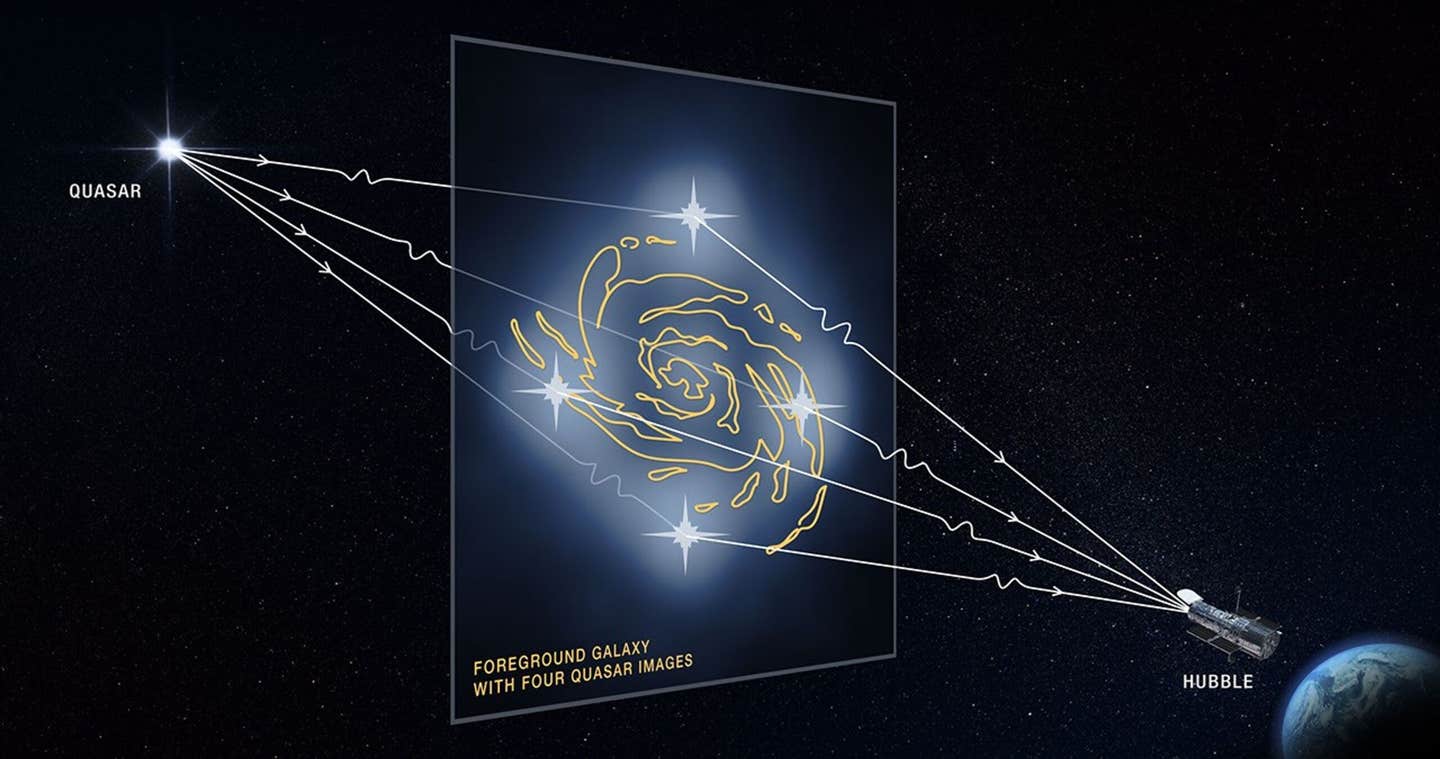Astrophysicists use quasars to detect invisible gravitational waves
Discover how astronomers use quasar motions to detect gravitational waves, opening new doors to understanding cosmic mysteries.

Researchers use quasar wiggles to set new limits on detecting elusive gravitational waves, offering fresh insights into the universe. (CREDIT: NASA)
Space might seem calm when gazing up at the night sky, but invisible waves ripple continuously through the universe, bending space and time. These waves, known as gravitational waves, carry crucial clues about cosmic events. Scientists from the University of Colorado Boulder are taking a fresh approach to detecting these elusive signals. Their method uses the subtle wiggles of distant celestial objects known as quasars.
Astrophysicist Jeremy Darling and his team recently used new data from the European Space Agency’s Gaia satellite. Gaia has observed the precise movements of over a million quasars. Darling examined the data from Gaia to understand how gravitational waves might be shifting these quasars' positions.
How Cosmic Waves Move Quasars
Quasars, incredibly bright black holes at the center of distant galaxies, appear stationary. Yet, gravitational waves traveling through space gently deflect the path of quasar light reaching Earth, creating tiny movements in their apparent positions. Detecting these subtle movements requires exceptional precision. Darling describes it as needing to spot the growth of a human fingernail from Earth to the Moon—a seemingly impossible task.
“If you lived for millions of years, and you could actually observe these incredibly tiny motions, you’d see these quasars wiggling back and forth,” Darling explained.
Currently, researchers use radio signals from pulsars—rapidly spinning stars—to detect gravitational waves. In 2023, the NANOGrav collaboration found evidence of gravitational waves by observing how pulsars' signals changed as space-time stretched and compressed. But this method only detects gravitational waves moving in one direction—like waves crashing toward a shoreline.
Darling’s method, on the other hand, could detect gravitational waves moving in multiple directions. "Gravitational waves operate in three dimensions," he said. "They stretch and squeeze spacetime along our line of sight, but they also cause objects to appear to move back and forth in the sky."
Related Stories
Measuring Gravitational Waves with Precision
To find these cosmic signals, Darling paired up over two billion measurements from quasars collected by Gaia. He studied how each pair of quasars moved relative to one another, creating what astronomers call an "astrometric Hellings–Downs curve." This curve measures how gravitational waves shift quasars based on their positions in the sky.
Darling’s team found no definite signal of gravitational waves yet. However, they set the tightest limit ever on how strong these gravitational waves might be. They established that these waves are incredibly subtle, no stronger than a characteristic strain of just 2.7 × 10⁻¹² at frequencies around one cycle per year. This limit surpasses earlier results achieved through radio-wave observations.
Gaia’s precision allowed the researchers to set this new boundary. But the Gaia data did reveal some quirks—unexpected motions in quasars possibly caused by small measurement errors. Such errors create difficulties in clearly identifying gravitational waves but did not entirely overshadow the results.
Why These Waves Matter
Why go through so much effort to detect gravitational waves? Darling emphasized that these waves provide invaluable insights into fundamental physics. When massive black holes spiral and collide, they unleash gravitational waves powerful enough to ripple throughout space.
"There is a lot we can learn from getting these precise measurements of gravitational waves," Darling said. "Different flavors of gravity could lead to lots of different kinds of gravitational waves."
Observing these subtle movements could help scientists distinguish between gravitational waves originating from massive black holes and other sources, such as cosmic events that happened just after the Big Bang. Understanding these differences would significantly enhance scientists’ knowledge of galaxy formation and evolution.
Scientists already know gravitational waves exist. The LIGO observatory famously detected waves from black hole mergers at frequencies between 35 and 250 Hz. Pulsar observations have also spotted a background of gravitational waves at much lower frequencies, between 2 and 28 billionths of a Hertz (nHz). But identifying gravitational waves at the intermediate frequencies accessible by Gaia could solve critical mysteries about cosmic history.
Challenges and Future Prospects
Detecting gravitational waves through quasar motions is tough. Earth's constant movement through space complicates measurements. Our planet orbits the sun at roughly 67,000 miles per hour, and the sun itself speeds through the galaxy at about 850,000 miles per hour. Researchers must filter out these motions to spot the extremely delicate signals caused by gravitational waves.
Despite these challenges, Gaia will soon deliver even more extensive data. In 2026, scientists will gain access to over five additional years of quasar measurements. Darling remains optimistic that future data could reveal the elusive gravitational waves.
“If we can see millions of quasars, then maybe we can find these signals buried in that very large dataset,” he said.
Darling’s method marks a promising step in astrophysics, potentially revealing more about gravity, galaxy evolution, and even the universe's earliest moments. While the signals are faint, the importance of these cosmic whispers is profound, providing hints about the nature of reality itself.
Research findings are available online in The Astrophysical Journal Letters.
Note: The article above provided above by The Brighter Side of News.
Like these kind of feel good stories? Get The Brighter Side of News' newsletter.



